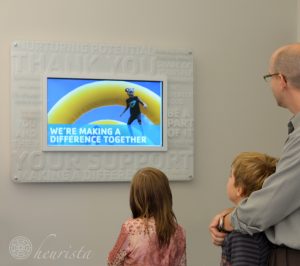Technology was already a consistent component of our lives before the social distancing orders brought about by a global pandemic. With both science and public opinion pointing to a new normal where limited physical interaction becomes routine, people are turning to technology to maintain our important relationships. Baby Boomer to Gen Z, we’re now using technology for distance learning, telehealth appointments, online entertainment, virtual meetings, and personal conversations.
Nonprofits must engage and inspire their audiences through virtual technology, too. Virtual experiences are the go-to solution for sustaining the philanthropic relationships that nonprofits rely on to meet their missions. Technology is more than a response to this emergency. It should be seen as an opportunity to put new tools to use, to innovate and disrupt our traditional, event, and facility-based habits. Technology is reducing traditional engagement participation barriers, providing efficiencies and cost-savings, and generating new, distinctly 21st century methods for building a culture of philanthropy.
Almost instantly, concerns that donors won’t use technology have vanished. As a society, we’ve accepted that web-based technologies are the solution for most communication needs and we’ve had lots of opportunities to practice using them. We have learned through experience: it is possible to create meaningful connections even if we are not physically together.
What is digital donor recognition?
Multiple terms are used for donor recognition presented via electronic screens. We draw the following distinctions knowing that there is overlap between the three definitions:
Digital donor recognition began in the mid-1990’s and allowed for the presentation of list and graphics on screens located at a nonprofits’ campus and often incorporated into a traditional donor wall. Digital donor recognition can be still or animated. Likewise, touchscreens may be used to allow for viewer interaction.
Online recognition is, for the sake of this article, a listing of donor names and/or stories on an organization’s website. The format usually follows the traditions established for a printed annual report.
Virtual donor recognition is fully interactive content that can be accessed from any web-enabled device and presented on-campus electronic screens. It gives remote access to content that is conceptually linked to on campus content and may include tours and video as well as links to other online resources.
Digital/Online/Virtual Donor Recognition: What expectations should you have?
1. Invest wisely
While the decision to invest in virtual technology may be driven by immediate circumstances, virtual recognition provides long-term value. Like the best of its traditional counterparts, virtual donor recognition encourages affinity and greater giving, facilitates providing a larger volume of information, and does so regardless of where the donor is.
2. Access content online
Superior virtual donor recognition presents information on any web-enabled device as well as on display screens. This means your fundraisers and donors can access content on their own phones, tablets, or computers as well as when they’re on campus. The virtual experience mirrors the real-world experience.
3. Create dynamic content
Virtual recognition facilitates complex philanthropic storytelling, giving audiences dynamic, interconnected information about those who support your organization and why they give. Stories communicate the variety of ways to support the organization and demonstrate the impact of philanthropic giving.
4. Organize information to attract multiple audiences
Virtual recognition anticipates different interests and levels of viewer interactivity. Information can be categorized, featured, and linked allowing users to self-propel through the content without ever leaving the fully-branded experience. Self-directing through the virtual experience increases the viewers’ involvement and comprehension and extends the amount of time spent exploring.
5. Alleviate space limitations
Unlike traditional donor walls or websites, virtual recognition is infinitely scalable. There are no limits to the number of donors that can be included or the stories that can be told about a particular donor or topic. Best yet, content can be interconnected, helping donors better understand the connection between their giving and the accomplishment of the nonprofit’s mission.
6. Share content through social media and email
Sharing donor and mission-specific information through social media is easy because the content is already housed online. Donors become advocates for the organization’s mission and attract new donors through their stories. Those new viewers are linked through to the virtual experience where they can continue to browse on their own.
Until recently, donor recognition was too often just a list of names. Digital donor recognition – putting lists and stories on screens in tandem with or in lieu of traditional donor walls – has been growing in popularity. With the pivot to all-virtual donor engagement strategies, nonprofits need to present content wherever the donor may be. There are few tools ready to meet that need.
Heurista is responding to the call for virtual donor recognition with Philanthrosphere®, a web-based platform designed specifically for donor stewardship. It facilitates list management, creates comprehensive donor profiles, links all content to mission-specific stories, and provides multiple tools for categorizing, searching, and touring content. Most importantly, it can be accessed by any web-enabled device and content can be shared… by fundraisers and donors alike.
Nonprofits know they need more opportunities for donor engagement and they need it now. Story, context, and shared experience are the building blocks of community. Carefully crafted, the virtual donor recognition experience can provide these experiences along with greater access, ease of use, cost-efficiency, and a larger audience of potential supporters. Necessity is propelling us into donor recognition in the digital age.
Visit the Heurista website to see examples, read more about the Philanthrosphere® features, or schedule a virtual donor recognition demonstration.
Written By Anne Manner-McLarty
Anne Manner-McLarty is the managing editor of the Journal of Donor Relations and Stewardship and the founder and lead strategist of Heurista. Founded in 2011, Heurista is the leading resource for consulting specific to donor relations and stewardship, with particular expertise in the donor recognition program design and implementation.


